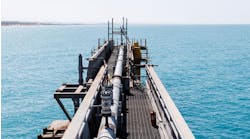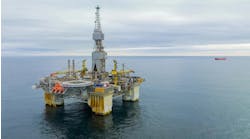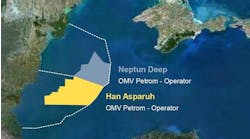Gas field developments hasten industrialization of coastal regions
Jeremy Beckman
Editor, Europe
Tanzania, Madagascar exploration revived
Canadian companies are bidding to bring offshore gas to the East African mainland. Two development schemes are under review off Tanzania which would alleviate local dependence on diesel fuel and hydro-electricity for power generation.
Two consortia are managing these projects, which include establishing processing facilities and pipelines in areas short of oil industry infrastructure. One of the companies concerned, Tornado Resources, is also preparing to explore for gas offshore Kenya.
In Tanzania, problems with rainfall, maintenance, and management of the country's hydro-electric dams caused the government to seek alternative sources of power supply. One of these is thermal generation using offshore gas, known to exist in ample quantities in Mnazi Bay to the south and around Songo Songo Island to the north.
Studies for Songo Songo were completed in mid-1997, but have since been stalled by a dispute between Tanzanian power authority Tanesco and a Malaysian-financed company, IPTL, over the latter's newly built 100 MW thermal power station. IPTL demanded supplements which Tenesco has refused to pay. The impasse caused the Songo Songo alliance to question whether the government could afford multiple power projects, hence their decision to suspend activities. In December, however, Tanesco/IPTL agreed to refer the matter to international arbitration. If this can be resolved quickly, work on Songo Songo could resume by mid-1999. Currently, the partners are reworking their cost estimates, according to Mike Heule, Vice President, Special Projects at Calgary-based Ocelot Energy.
Much of coastal Tanzania is covered by a sedimentary basin which extends to the edge of the continental shelf. The area on and just offshore Songo Songo Island was first explored in the 1970s. Agip discovered gas there in 1978.
Revived project
Tanzania Petroleum Development Corporation and Indian Oil Company revived the drilling effort in the 1980s, but like Agip, were stumped by the poor prospects for a commercial deal. With most of its population strung out in small pockets, even today less than 10% of Tanzanians have access to electricity.However, there were potential industrial users a short distance up the coast from Songo Songo, as well as a refinery across the border in Mombasa. With this in mind, a new consortium began re-evaluating prospects in 1991, comprising Ocelot, TransCanada Pipelines, the Tanzanian government and the World Bank. Memoranda of understanding (MOU), signed in 1993, have formed the basis for the current project. An MOU with Kenya Power and Light may form the basis for future expansions of the project.
Agreements over the current Songas project were initiated in 1997. Under the first phase, a new company called Songas was created to design and install the necessary infrastructure. This included the addition of two new gas turbines at the Ubungo thermal power plant, which has been achieved, raising capacity there to 110 MW.
The second, full development phase includes commissioning of a gas processing plant on Songo Songo Island to handle the wellstream of the five off and onshore wells, and installation of a 232 km, 12-in. diameter marine/onshore pipeline which would take the gas north to Ubungo and Dar es Salaam, with a spur line from the Ubungo area carrying further gas supplies to a cement plant at Wazo Hill.
Project viability
Prior to the suspension, the overall project cost was estimated at $370 million, with the World Bank providing debt financing of $200 million through an International Development Association credit. Ocelot and TransCanada Pipelines are investing $50 million and will operate the project for its first 20 years."We may also look to invest in the electrical transmission system, or expansion of the pipeline network," says Heule. "There are three possible requirements - one is to tie in the country's gold mines, which would mean expansion of the electrical grid into Tanzania's north-west portion. This is a potential 100 MW market that Tanesco can't serve currently. The second is to tie a line either from Tanga or from Dar Es Salaam northwards to Mombasa - again to supply a potential new 100 MW market. Finally, the pipeline could be extended from Dar Es Salaam to Mombasa for industrial and electrical usage."
The Songo Songo reservoir has been pretty well mapped, Heule says, with 0.7-1.5 tcf of gas thought to be in place. Workovers had to be conducted on the three offshore and two onshore wells around the island during 1996-97. Since cessation of drilling in the early 1980s, the wells had been neglected, and there was extensive corrosion. Once the wells had been made serviceable, however, they tested up to 100 MMcf/d combined at flowing pressures up to 2,200 psi.
Testing involved collecting gas samples, flaring each wells for several days and measuring the response in the reservoir with special gauges. "This material balance test was done with micro-tolerances," Heule says. "We were concerned at one point that the reservoir could be severely compartmentalized, but the tests proved it wasn't." Gas proved to be very dry with a 97% methane content.
The Songas sales agreement calls for supply of approximately 250bcf over 20 years at a rate of up to 40 MMcf/d. Processing will be managed via two dehydration and refrigeration plants on the island taking gas directly from the wells. Hydrocarbon liquids stripped out will be shipped to Dar Es Salaam or used on-site as fuel. Should further markets be secured, a third gas processing train might be added with compression boosting the pipeline throughput to 100 MMcf/d, if required.
Ocelot operates nine blocks within its license off Tanzania, so it has further exploration upside potential. If more gas were discovered, it might consider a gas-liquids conversion technology or fertilizer production. Exploration can be expensive, however. The patch reefs close to the coast necessitate use of a swamp barge for drilling which has to be hauled from Nigeria or the Far East. These reefs also militate against the use of seismic cables.
Assuming financial closure on Songas goes through shortly, the project could be on stream by late 2001. Ocelot was attracted to Tanzania partly because it had one of Africa's fastest privatization rates, but also because of the general social and business climate. "Although the country has as many different tribes as other states," Heule says, "this is a consensus-driven society. You're Tanzanian first, your tribe comes second. Hence, there's more stability. In fact, the whole East Africa alliance is a stable place to do business."
Mtwara build-up
Tanzania's other offshore development is near the southern border with Mozambique, at Mnazi Bay. Here Tornado Resources and Caterpilar Power Ventures International are shaping to bring gas to a 15 MW power generation plant in Mtwara, currently fuelled by diesel.Mtwara is one of only four deep natural harbors on the East African coast. Large-scale development of the harbor was undertaken in the late 1980s, in anticipation that it would become a regional trade hub. But the expected industrialization inland did not take place.
Activity should pick up, however, following the decision to commercialize Mnazi Bay's gas, which has lain unexploited since its discovery by Agip in 1982. The government of Tanzania is in the final stages of a decision process that would see the Tornado-Caterpillar consortium install 15 MW of gas-fired reciprocating engine capacity at Mtwara, fuelled from the Mnazi Bay reservoir. The facility would provide power to Mtwara and, through an expansion of the regional transmission infrastructure, to the neighboring towns of Lindi and Masasi.
Other potential customers could be a cement factory, agricultural processing, development of the coastal fishery, a new fertilizer plant planned by the government in southern Tanzania, and also potentially Mozambique, which has approached the government about sourcing power from the planned facility at Mtwara.
Oil was Agip's original target. In fact, the Mnazi Bay-1 well encountered seven gas zones, two of which were production tested - the upper of these zones flowed 12.5 MMcf/d while the lower generated 13.5 MMcf/d. Tornado plans to re-enter the well and run a dual completion on these wells.
The large, highly pressurized reservoir is thought to hold around 400 bcf recoverable, but in view of the modest requirements from Mtwara, initial production will be limited to 3 mcf/d. "There's no sense in developing the field further until there is evidence for load growth," says Tony Reinsch, Executive Vice President at Tornado Resources. Even without the extra customers, the $27 million project's economics remain "significant", he claims.
A permanent production platform will be installed in the shallow waters of Mnazi Bay (18 ft at high tide, 5 ft at low tide). This will be an ultra-minimal facility, basically housing processing equipment. It will likely be the same structure used for the well re-entry. According to Reinsch, the gas is perfect for power feedstock, but is not suited to liquefaction or petrochemical applications, being 98% methane. Gas will be piped to Mtwara through a 24 km pipeline, the first 7.7 km being marine.
Kenya
Tornado was alerted to opportunities in Kenya (as in Tanzania) by an associate of the company. Following contacts with the Kenyan National Oil Corporation (NOCK), it signed PSCs in 1997 covering the on/offshore block L-10 in the Lamu Basin and the inland block L-1 in the Mandera Basin. The work program includes two exploration wells and acquisition of 275 km of seismic. Shell was the last company to drill in Kenya, finding non-commercial hydrocarbon traces in the northwestern Turkani region in 1987. Interest then waned as other regions such as the FSU opened up.Although East Africa is not an exploration hot-spot (compared with the west coast), the geology of the Kenyan blocks was appealing, Reinsch says. Tornado was also drawn by the conditions for foreign investors, which included friendly production sharing contract (PSC) terms covering repatriation of profits. And the blocks are not ring fenced, which allows Tornado to expand its work commitments wherever the best opportunities arise.
Kenya de-regulated its domestic petroleum products market in 1994, attracting numerous international oil companies. However, the country is totally reliant on imported crude to meet its annual energy requirements of 3 million toe, with no commercial discoveries of oil or natural gas.
The power market holds greater potential than Tanzania's, with electricity demand forecast to grow by 5% from 1997-2007. Unfortunately, the system cannot always cope with the demand, with chronic peak load shedding occurring at times, causing economic losses.
The immediate requirement for extra gas-fired power capacity is estimated at 350 MW-plus. Much of the economic growth is expected to be focused around Mombasa, which lies conveniently close to the L10 block - and within reach by pipeline.
Acreage in L10 extends over 6,967 sq km to the area south of Mombasa and then offshore. Water depths vary from 10-15 meters near shore to 150-200 meters. Seven leads have been identified from the existing 2D seismic (shot in the early 1990s) at total depths of 1,000-1,300 meters. Seismic has still to be put out to tender - ideally, Tornado would like to time-share a vessel with other companies exploring off East Africa.
The drilling plays targeted look relatively inexpensive, Reinsch says, but they would still be wildcats. An oil major would need to be co-opted as lead partner in the PSC to ease the drilling burden. A barge with a moonpool would likely be employed for the near-shore prospects.
Two of the four wells drilled to date in the Lamu basin region have penetrated excellent source rock sequences, according to Tornado. One of the wells, south of L10 on the coastal plain, encountered a thick, mature, gas-prone horizon. Another on Pemba Island, 46 km to the southeast, penetrated a rich oil-prone source rock, and seismic correlations suggest this source rock is also present in L10. Block faulting also provides structural traps along the coastline. "Currently we are investigating top and lateral seals for viability," says Reinsch.
Copyright 1999 Oil & Gas Journal. All Rights Reserved.


